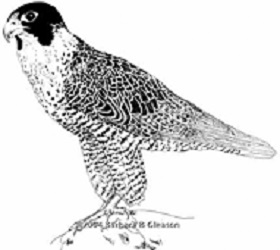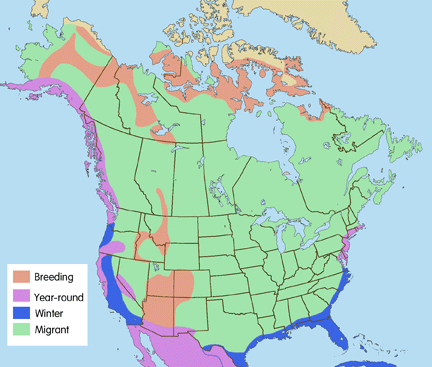
Scientific Name: Falco peregrinus anatum
A large, dark, powerful falcon with long, pointed wings and a long, narrow, tapered tail. Plumage is similar between the sexes, but females are larger. The Peregrine Falcon has a black hood that extends down along the side of the head in a distinctive wide mustache mark. Upper parts of the bird are a dark slate-gray and lightly barred; underparts are a whitish color at the throat, shading to a buffy color with elongated spots on the chest, and more dark barring across the abdomen; legs and feet of the adult are bright yellow. Like all other members of the falcon family, the Peregrine has a distinct notch in the upper mandible for cervical dislocation of its prey. This falcon flies with smooth, shallow, powerful wing beats, often soaring high with wings out flat and tail fanned when searching for prey, then diving and maneuvering at high speed to strike birds in midair. Peregrines are capable of gliding and flapping speeds up to 60 mph, and of reaching speeds up to 200 mph in spectacular dives called stoops.
Male
Length: 14 – 16″
Wingspan: 37 – 39″
Weight: 1 – 1.5 lb.
Female
Length: 16 – 20″
Wingspan: 40 – 46″
Weight: 1.6 – 2.1 lb.
State and federally protected. Once on the edge of extinction in North America from pesticide poisoning, Peregrines have made a remarkable recovery through captive breeding programs and were officially taken off the endangered species list in 1999.
Found in both forested and open country, up to about 10,000 feet. Usually live in an area with bluffs or cliffs overlooking rivers or lakes inland, or overlooking bays or ocean near an abundance of seabirds. Peregrines have learned the advantages of urban life in some regions, nesting on buildings and bridges, wherever pigeons are plentiful.
Almost all of their diet is small to medium-sized birds, usually captured in the air, but occasionally on the ground. The most common hunting technique is to hunt from a perch, taking off after passing birds; will also soar and circle, maneuver into position, and dive on prey to catch them in flight. Young Peregrines practice their midair hunting skills by going after flying insects.
Usually silent when alone, but vocal around other Peregrines. Will give a harsh rasping alarm call rehk…rehk…rehk if an intruder comes near the nest.
This falcon usually scrapes out a shallow hollow for the eggs in an inaccessible spot — on cliffs, high ledges, bluffs, or on ledges of buildings in cities. Will also reuse old nests of other species in trees. Peregrines may return to the same nest site over many generations.
Peregrines are not seen often at rehabilitation facilities, but when they do come in, it is often with wing injuries from hitting power lines.

World-wide distribution, mostly arctic to temperate zones. One or another of the several North American subgroups occurs in almost all parts of the continent at some time of the year. Arctic Peregrines migrate to South America to winter, where they continue to be at risk of pesticide poisoning.
Special Thanks for range maps:
Dan Gleason
BGleason Design & Illustration
Commercial & Scientific Illustration, Graphic Design
CraneDance Communications
Book Production/Design

